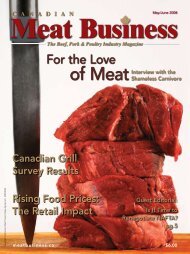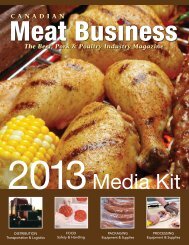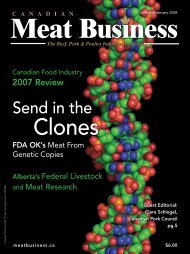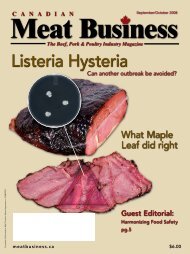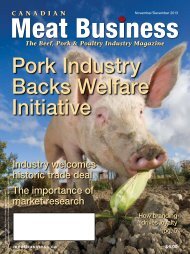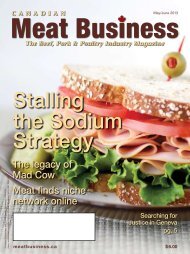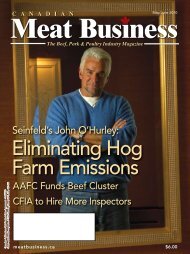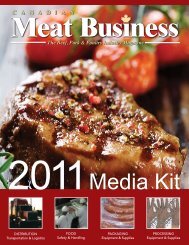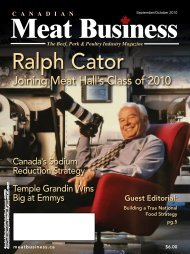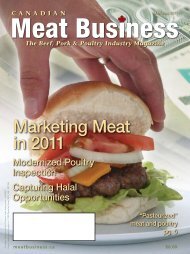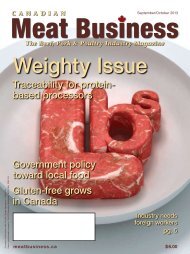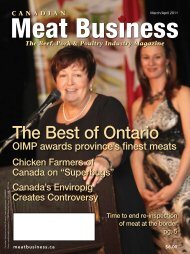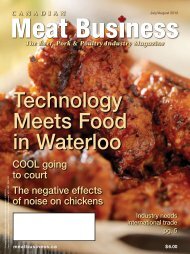Consumption on the Rise
Source - Canadian Meat Business
Source - Canadian Meat Business
- No tags were found...
You also want an ePaper? Increase the reach of your titles
YUMPU automatically turns print PDFs into web optimized ePapers that Google loves.
A “clear priority”<br />
According to <strong>the</strong> Manitoba Pork Council, which<br />
represents roughly 600 producers in <strong>the</strong> province, <strong>the</strong><br />
Lake Winnipeg Stewardship Board informati<strong>on</strong> indicates<br />
that all of agriculture in <strong>the</strong> watershed c<strong>on</strong>tributes just<br />
15 per cent of <strong>the</strong> phosphorus going into <strong>the</strong> lake, and<br />
pork producti<strong>on</strong> accounts for 1.5 per cent of that.<br />
+<br />
“Allowing <strong>the</strong> hog industry to<br />
expand without limit would put our<br />
rivers and lakes at risk,”<br />
– Dr. David Schindler of <strong>the</strong> University of Alberta<br />
The council said that protecting Lake Winnipeg and<br />
addressing excess phosphorus is a “clear priority.” In<br />
March <strong>the</strong> group released a report called Embracing a<br />
Sustainable Future, which addressed this issue.<br />
The following are several key points of Manitoba<br />
Pork’s phosphorous plan, dubbed “Plan P”:<br />
1. Asking <strong>the</strong> provincial government to join Manitoba<br />
Pork in persuading <strong>the</strong> federal government to end<br />
its requirement that phosphorus be added to all<br />
animal feed. This will reduce <strong>the</strong> phosphorus in <strong>the</strong><br />
manure applied as a crop nutrient (addressing feed<br />
ingredients and feed efficiency);<br />
2. Applying manure at rates suitable to match <strong>the</strong><br />
needs of <strong>the</strong> crop;<br />
3. Ei<strong>the</strong>r injecting <strong>the</strong> manure four to five inches below<br />
<strong>the</strong> soil surface, or surface applying and cultivating<br />
immediately to work it into <strong>the</strong> soil;<br />
4. Ending <strong>the</strong> former practice of applying manure <strong>on</strong>to<br />
frozen soils in winter (<strong>on</strong>ly a few small producers<br />
still do this);<br />
5. Adopt new manure handling methods and<br />
technologies such as solid-liquid separati<strong>on</strong>.<br />
Manitoba Pork plans to request that <strong>the</strong> Canadian<br />
Food Inspecti<strong>on</strong> Agency lower or remove its minimum<br />
required phosphorous levels in processed feeds, as<br />
<strong>the</strong> levels hold back producers’ efforts to reduce<br />
phosphorous.<br />
The council also said in will str<strong>on</strong>gly encourage pig<br />
producers to invest in manure separati<strong>on</strong> technology in<br />
those areas where it is difficult to access enough cropland<br />
to fully utilize all of <strong>the</strong> plant nutrients in manure.<br />
Manitoba Pork also noted that pork producti<strong>on</strong> in<br />
<strong>the</strong> province has shrunk since 2007 due to a c<strong>on</strong>fluence<br />
of factors, ec<strong>on</strong>omic and o<strong>the</strong>rwise. The populati<strong>on</strong> of<br />
pigs in Manitoba is probably around 2.5 milli<strong>on</strong> at any<br />
<strong>on</strong>e time (500,000 fewer than in 2007). A good porti<strong>on</strong><br />
(about 3.5 milli<strong>on</strong>) of <strong>the</strong> pigs produced in Manitoba<br />
are shipped out of <strong>the</strong> province when <strong>the</strong>y are still small<br />
weanlings and <strong>the</strong>ir manure output is much less than an<br />
older, larger pig.<br />
- staff<br />
meatbusiness.ca<br />
July/August 2011 Canadian Meat Business 17



